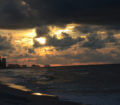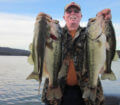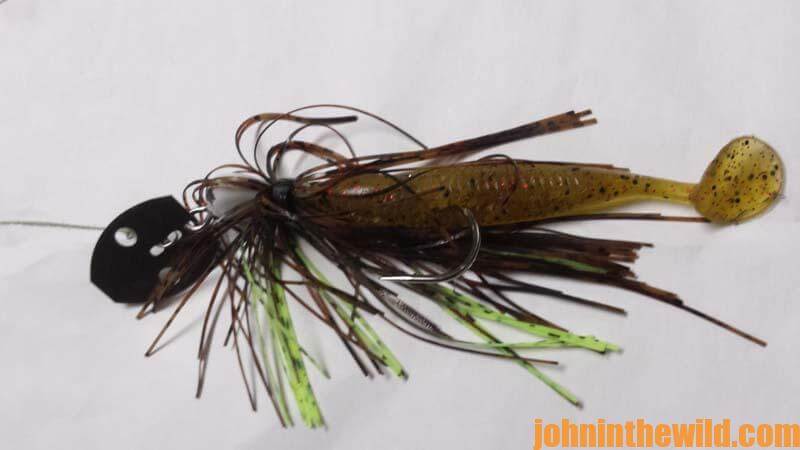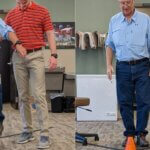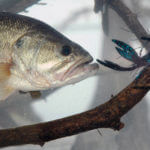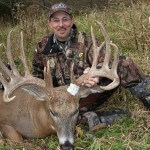Editor’s Note: Lake Guntersville (http://www.lakeguntersville.info/) is still kicking out monster bass, and anglers all across the country travel there to fish. In the first picture today, Phillip Criss, who guides on Guntersville Lake in north Alabama, is holding a 9-1/2-pounder that he caught mid-March, 2017. Criss fishes between 200 to 250 days a year on Lake Guntersville. If you throw in the number of days he fishes to find bass for his clients, he’s probably fishing 300 days per year. This week Criss will tell us the secrets to catching springtime Guntersville bass.
 Secret #1: Fish the middle of the week on Wednesdays or Thursdays for the most success. The first secret for catching big bass at Guntersville this year is don’t schedule your fishing trip for the weekend. For instance, last weekend we had eight major bass tournaments on the lake Friday, Saturday and Sunday. Your best day to take a big bass will be in the middle of the week – either on Wednesday or Thursday – when there’s not nearly as much fishing pressure on the lake as there is on the weekend. Right now, the bass are either shallow, or they’re moving to the shallows, getting ready for the spawn. The weather has been fairly consistent, until the extreme cold fronts of mid-March. However, even with the cold fronts, the bass that are in 2-3 feet deep water aren’t going to swim a mile or two away from the shallow water when cold fronts hit. They’ll usually move to the first drop-offs, often only a 1- to a 1-1/2-foot drop-off from the flats. That’s where they’ll hold until the water temperature warms up enough for them to move shallow again.
Secret #1: Fish the middle of the week on Wednesdays or Thursdays for the most success. The first secret for catching big bass at Guntersville this year is don’t schedule your fishing trip for the weekend. For instance, last weekend we had eight major bass tournaments on the lake Friday, Saturday and Sunday. Your best day to take a big bass will be in the middle of the week – either on Wednesday or Thursday – when there’s not nearly as much fishing pressure on the lake as there is on the weekend. Right now, the bass are either shallow, or they’re moving to the shallows, getting ready for the spawn. The weather has been fairly consistent, until the extreme cold fronts of mid-March. However, even with the cold fronts, the bass that are in 2-3 feet deep water aren’t going to swim a mile or two away from the shallow water when cold fronts hit. They’ll usually move to the first drop-offs, often only a 1- to a 1-1/2-foot drop-off from the flats. That’s where they’ll hold until the water temperature warms up enough for them to move shallow again.
Secret #2: Fish the lily pad stems and the edges of the grass. Right now in late March, the lily pad stems and some of the grassy areas on the lake seem to be holding the most bass.
 Secret #3: Fish chatterbaits. Our number-one bait at this time of the year in late March on Guntersville is the chatterbait that has a blade on the front of a jig that causes the jig to make noise as it swims through the water on the surface. Sometimes you can run that chatterbait fairly fast through the lily pad stems or down the edges of the grass. If the lake has had a cold front, we still will fish the chatterbait, but we’ll fish it much slower.
Secret #3: Fish chatterbaits. Our number-one bait at this time of the year in late March on Guntersville is the chatterbait that has a blade on the front of a jig that causes the jig to make noise as it swims through the water on the surface. Sometimes you can run that chatterbait fairly fast through the lily pad stems or down the edges of the grass. If the lake has had a cold front, we still will fish the chatterbait, but we’ll fish it much slower.
At first light, the bass may be somewhat reluctant to take the chatterbait. But once the sun comes out and warms-up the water in the shallows, the bass will bite more aggressively. Last week in mid-March, the best and the most bites came in the middle of the day from 10:00 am until 2:00 pm. For the last couple of weeks in March, the midday bite and the afternoon bite have resulted in the most strikes, and the most bass brought to the boat.
My favorite chatterbait is the Z-Man chatterbait (https://zmanfishing.com/store/categories/chatterbait) in a crawfish or a bluegill color or a shad pattern. Work that chatterbait as close to the root ball of the lily pad stems as you can. When I’m fishing the chatterbait, I use 65-pound test PowerPro (http://www.powerpro.com) braided line, because if a big bass takes the bait and wraps you up in the lily-pad stems, you want a line strong enough to either cut the lily pad stems or pull the bass out of that kind of cover.
 I put my braided line on a Boyd Duckett heavy-action rod (http://duckettfishing.com) that is 7’3” to 7’6” long, and I use a wide spool baitcasting reel. Braided line tends to work better on a wide spool reel than it does on a narrow spool reel. When you’re reeling the braided line in with a big fish, it doesn’t pull down into the reel as bad as it does on a narrow spool reel. With a wide spool reel, you can cast your chatterbait farther and still have plenty of line left on the reel. You also can reel the bait slower on a wide spool reel than you can on a narrow spool reel.
I put my braided line on a Boyd Duckett heavy-action rod (http://duckettfishing.com) that is 7’3” to 7’6” long, and I use a wide spool baitcasting reel. Braided line tends to work better on a wide spool reel than it does on a narrow spool reel. When you’re reeling the braided line in with a big fish, it doesn’t pull down into the reel as bad as it does on a narrow spool reel. With a wide spool reel, you can cast your chatterbait farther and still have plenty of line left on the reel. You also can reel the bait slower on a wide spool reel than you can on a narrow spool reel.
Contact Phillip Criss on Lake Guntersville by calling 205-461-5549.
To learn more about bass fishing, get John E. Phillips’ Kindle eBooks, print books and audiobook on bass fishing, go https://johninthewild.com/books/#bass, or for Nook books, visit www.barnesandnoble.com.

